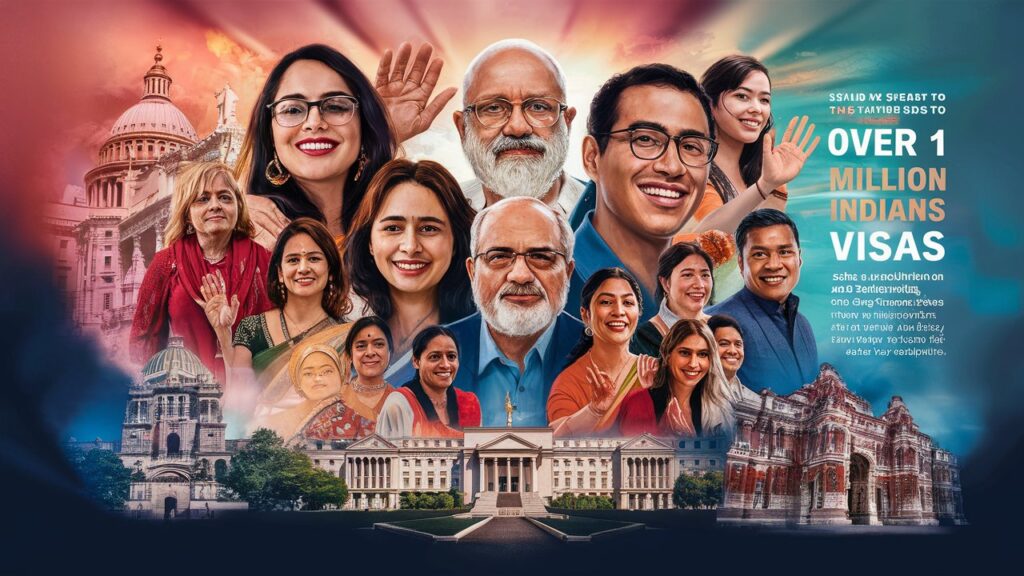In recent years, the United States has witnessed a notable increase in the number of visas granted to Indian citizens, reflecting various economic, social, and geopolitical factors. This surge not only underscores the growing bilateral relations between the two nations but also highlights the diverse reasons driving Indians to seek visas for the U.S.
Understanding Visa Categories
- Work Visas (H-1B, L-1): Many Indian professionals seek work visas to pursue career opportunities in the U.S. The H-1B visa, in particular, is popular among skilled workers in fields such as technology, healthcare, and finance.
- Student Visas (F-1, J-1): Indian students continue to flock to American universities for higher education. The F-1 visa allows them to study at accredited institutions, while the J-1 visa facilitates cultural exchange programs.
- Tourist and Business Visas (B-1/B-2): Visas for tourism and business purposes remain essential for Indians traveling to the U.S. for leisure, conferences, or business meetings.
- Immigrant Visas (Green Cards): Many Indians apply for immigrant visas, seeking to become lawful permanent residents (Green Card holders) in the U.S. through family sponsorship, employment, or diversity visa programs.
Factors Driving the Increase
- Economic Opportunities: The U.S. continues to attract skilled Indian professionals due to its robust job market and opportunities for career advancement in sectors requiring specialized skills.
- Educational Excellence: American universities are renowned for their academic excellence and research opportunities, attracting a large number of Indian students pursuing undergraduate, graduate, and doctoral degrees.
- Family Reunification: Many Indian-Americans sponsor relatives for family-based immigrant visas, fostering family reunification and community ties across borders.
- Bilateral Relations: Strengthened diplomatic ties between India and the U.S. have facilitated smoother visa processes and collaborations in various sectors, including technology, defense, and trade.
Challenges and Considerations
- Visa Processing Delays: Despite the increasing number of visas issued, applicants often face delays in visa processing due to administrative backlogs or policy changes.
- Policy Uncertainties: Changes in U.S. immigration policies, such as visa restrictions or revisions, can impact the issuance and types of visas available to Indian nationals.
- Competitive Application Process: The competitive nature of visa programs, particularly the H-1B visa lottery, underscores the importance of strategic planning and preparation for applicants.
Impact on Individuals and Society
- Career Advancement: Access to U.S. visas provides Indian professionals with opportunities to enhance their skills, gain international experience, and contribute to global enterprises.
- Educational Excellence: Indian students benefit from exposure to diverse academic environments, fostering intellectual growth, and preparing them for global careers.
- Cultural Exchange: Visas for tourism, business, and cultural exchange programs promote mutual understanding and strengthen people-to-people ties between India and the U.S.
Future Trends and Outlook
- Technological Advancements: Innovations in visa processing systems and digital platforms enhance efficiency and transparency, improving the overall visa application experience.
- Education and Skill Development: Continued investments in education and skills training in India prepare individuals for competitive visa categories and global job markets.
- Global Mobility: Evolving trends in remote work and digital nomadism reshape traditional employment models, influencing visa policies and international mobility patterns.
Focus on Student Visas
One of the primary areas of focus is student visas. The US has pledged to process all student visa applications for Indian students whose courses begin this fall. This initiative underscores the importance of educational exchanges and the significant contribution of Indian students to American universities. By prioritizing these applications, the US aims to facilitate smoother transitions for students and support their academic ambitions.
Addressing the Backlog
The backlog of visa applications has been a pressing issue, particularly for those seeking B1 (business) and B2 (tourist) visas. These categories have seen a surge in demand as business and leisure travel resumes post-pandemic. The US is actively working to reduce wait times and improve the overall efficiency of the visa issuance process, ensuring that applicants can proceed with their travel plans without undue delays.
Prioritizing H-1B and L Visas
Indian IT professionals have long been significant in the US, contributing to the tech industry and driving innovation. Recognizing this, the US prioritizes H-1B and L visas, which are crucial for skilled workers and intra-company transferees. These visas enable Indian professionals to work in the US, fostering cross-border collaboration and benefiting both economies.

Strengthening Bilateral Relations
The decision to increase visa issuance is not just about numbers; it is a testament to the deepening relationship between India and the US. This move will enhance people-to-people ties, promote cultural exchanges, and bolster economic cooperation. By facilitating more accessible visa access, both countries can benefit from their citizens’ diverse talents and skills.
Economic Implications
The issuance of over one million visas to Indians will have significant economic implications. For the US, it means a steady influx of skilled professionals, students, and tourists, all contributing to the economy in various ways. For India, it provides opportunities for its citizens to gain global exposure, enhance their skills, and bring back valuable experiences.
Cultural Exchange and Diversity
Cultural exchange is a cornerstone of the US-India relationship. By welcoming more Indian nationals, the US enriches its cultural tapestry and promotes diversity. Indian students and professionals bring unique perspectives and ideas, fostering a more inclusive and innovative environment.
Challenges and Solutions
Despite the positive outlook, challenges still need to be solved in managing the high volume of visa applications. The US government is investing in technological upgrades and additional staffing to expedite the process. These measures aim to ensure that the visa issuance system can handle the increased demand efficiently.

Long-Term Impact
The long-term impact of issuing over one million visas to Indians extends beyond immediate economic and cultural benefits. It sets the stage for stronger bilateral cooperation in various fields, including technology, education, and business. As more Indians travel to the US for education and work, they build networks leading to future collaborations and partnerships.
Result
The US’s decision to grant more than one million visas to Indian nationals in 2023 is a historic move that highlights the importance of the bilateral relationship. By addressing the backlog, prioritizing key visa categories, and facilitating smoother processes for students and professionals, the US is demonstrating its commitment to strengthening ties with India. This initiative promises to bring both nations economic, cultural, and social benefits, fostering a deeper and more dynamic partnership.
Conclusion
The trend of the U.S. granting over 1 million visas to Indians this year reflects deepening ties, shared aspirations for growth, and opportunities for collaboration between the two nations. As both countries navigate challenges and opportunities in the immigration landscape, fostering inclusive policies and promoting global mobility remains crucial for sustaining economic vitality and cultural enrichment.
